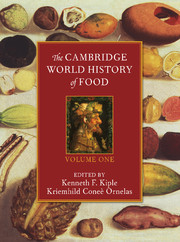Book contents
- Frontmatter
- Introduction
- Part I Determining What Our Ancestors Ate
- Part II Staple Foods: Domesticated Plants and Animals
- II.A Grains
- II.B Roots, Tubers, and Other Starchy Staples
- II.C Important Vegetable Supplements
- II.D Staple Nuts
- II.E Animal, Marine, and Vegetable Oils
- II.E.1 An Overview of Oils and Fats, with a Special Emphasis on Olive Oil
- II.E.2 Coconut
- II.E.3 Palm Oil
- II.E.4 Sesame
- II.E.5 Soybean
- II.E.6 Sunflower
- II.F Trading in Tastes
- II.G Important Foods from Animal Sources
- Part III Dietary Liquids
- Part IV The Nutrients – Deficiencies, Surfeits, and Food-Related Disorders
- References
II.E.3 - Palm Oil
from II.E - Animal, Marine, and Vegetable Oils
Published online by Cambridge University Press: 28 March 2008
- Frontmatter
- Introduction
- Part I Determining What Our Ancestors Ate
- Part II Staple Foods: Domesticated Plants and Animals
- II.A Grains
- II.B Roots, Tubers, and Other Starchy Staples
- II.C Important Vegetable Supplements
- II.D Staple Nuts
- II.E Animal, Marine, and Vegetable Oils
- II.E.1 An Overview of Oils and Fats, with a Special Emphasis on Olive Oil
- II.E.2 Coconut
- II.E.3 Palm Oil
- II.E.4 Sesame
- II.E.5 Soybean
- II.E.6 Sunflower
- II.F Trading in Tastes
- II.G Important Foods from Animal Sources
- Part III Dietary Liquids
- Part IV The Nutrients – Deficiencies, Surfeits, and Food-Related Disorders
- References
Summary
The oil palm (Elaeis guineensis) is a native of West Africa. It flourishes in the humid tropics in groves of varying density, mainly in the coastal belt between 10 degrees north latitude and 10 degrees south latitude. It is also found up to 20 degrees south latitude in Central and East Africa and Madagascar in isolated localities with a suitable rainfall. It grows on relatively open ground and, therefore, originally spread along the banks of rivers and later on land cleared by humans for long-fallow cultivation (Hartley 1988: 5–7).
The palm fruit develops in dense bunches weighing 10 kilograms (kg) or more and containing more than a thousand individual fruits similar in size to a small plum. Palm oil is obtained from the flesh of the fruit and probably formed part of the food supply of the indigenous populations long before recorded history. It may also have been traded overland, since archaeological evidence indicates that palm oil was most likely available in ancient Egypt. The excavation of an early tomb at Abydos, dated to 3000 B.C., yielded “a mass of several Kilograms still in the shape of the vessel which contained it” (Friedel 1897).
A sample of the tomb material was submitted to careful chemical analysis and found to consist mainly of palmitic acid, glycerol in the combined and free state, and a mixture of azelaic and pimelic acids. The latter compounds are normal oxidation products of fatty acids, and the analyst concluded that the original material was probably palm oil, partly hydrolyzed and oxidized during its long storage.
- Type
- Chapter
- Information
- The Cambridge World History of Food , pp. 397 - 411Publisher: Cambridge University PressPrint publication year: 2000
References
- 23
- Cited by

